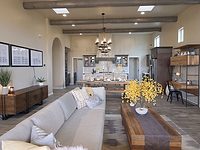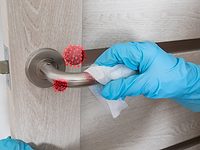Fibrillated Cellulose: A Bio-Based Rheology Modifier That Improves Tensile Strength and Surface Properties of Roof Coatings

Across a wide variety of industrial applications, consumers are seeking more natural ingredients that can increase the sustainability of the final formula while maintaining or improving the formulation's performance compared to synthetic incumbents. Although the demand is clear, companies still struggle to find a suitable replacement that provides unique rheology and other benefits associated with artificial compounds. That is where fibrillated cellulose comes in. Fibrillated cellulose is a renewable material that delivers multiple functionalities to coatings applications, from rheology to stability and surface properties, as well as supporting a more sustainable lifecycle.
What is Fibrillated Cellulose?
Fibrillated cellulose is manufactured by mechanically processing natural and sustainably sourced cellulose fibers down to their smallest components, cellulose fibrils, and the surface area dramatically increases. When suspended in water, the fibrils form a 3D network through mechanical entanglements and hydrogen bonding. This strong connection between the fibrils facilitate stabilization at low viscosity while providing shear thinning and thixotropic properties, as well as physical reinforcement.
Roof Coatings
Roof coatings, or elastomeric roof coatings, are applied to a variety of roof types to protect and seal the underlying roofing material and limit future weathering. These types of coatings are designed to ‘move’ with the roof and maintain elasticity to ensure long-term durability. Elastomeric roof coatings must show excellent adhesion to the substrate, since they can be applied to several types of roofs such as metal, concrete, bitumen and others.
Roof coating formulations can be solvent based, water based, and solvent free, and are formulated using different binders, depending on the final requirements needed.
In such applications, elongation and tensile strength are critical to ensure longevity. The rheology of a roof coating formulation plays a crucial role in the workability, ease of application, and the potential to apply a thicker layer via spraying or roller application with a reduced amount of time and defects (mud cracking). Lower dust/dirt capturing is also key to ensure prolonged efficiency and maintained surface whiteness, which reflects heat. This aspect is measured by dirt pickup resistance.
Features and Benefits
Valida fibrillated cellulose shows highly shear thinning and pseudoplastic behavior. Its high viscosity at low shear (i.e., at rest) improves stability, anti-settling, and anti-sagging properties of formulations, while the highly shear thinning behavior facilitates application to surfaces by spray or other means (Table 1 and Figure 1).


Elastomeric Roof Coating: Case Study
In this case study, fibrillated cellulose delivered in paste form (8% solid content) was used in an elastomeric roof coating formulation and benchmarked with some of the conventional solutions commonly adopted: HEC (Hydroxyethyl Cellulose) and HEUR. Given the feature of this specific coating, a one-to-one replacement was carried out. The formulation was centered around a styrene acrylic binder (Table 2).

Rheology Modification
Fibrillated cellulose was added as a multi-functional stabilizer. As a stabilizer, Valida's high viscosity at rest improves anti-settling behavior, eliminates hard settling, and reduces phase separation. This feature, combined with a balanced structure recovery due to Valida's thixotropic rheology profile, reduces sagging and dripping of the formulation post-application, which is to the benefit of application on sloped surfaces.
Aside from the rheological features that fibrillated cellulose imparts to formulations, it also enhances roof coatings in terms of mechanical reinforcement and surface improvement.
Figures 2 and 3 show a comparison between KU (Krebs Unit) and ICI (high-shear) viscosity of the Valida-based formulation and two similar formulations based on HEC and HEUR. Respectively, unlike HEC and HEUR, the Valida-based formulation shows a lower viscosity build-up, while formulation stability is maintained. The lower KU and ICI viscosity show that Valida is not a thickener. As mentioned, fibrillated cellulose, at the advised dosage, does not act as a thickener, contrary to the incumbents.


Mud-Cracking Resistance
Elastomeric roof coatings are usually applied at a higher layer thickness compared to conventional coatings. High-build coatings can suffer from cracking during drying. The water retention and 3D fiber structure of fibrillated cellulose will solve this issue.
The mud-cracking test was performed in accordance with AS/NZS 1580.409.1 (Australian and New Zealand standard) on concrete slabs. The samples were applied as a 5-8 mm wet film (Figure 4).

Valida S231C @ 5% dosage as received. Valida S231C consists of 8% active content suspended in 92% water.
Dirt Pick Up
When the coating gets darker due to dusting, dirt particles, particulate accumulation and residence time on the surface, the increased heat uptake will lower the efficiency of the coating. This is known as dirt pick-up. Low dirt pick-up is a key requirement for roof coatings to reflect the sun’s heat away from the building. To fulfil this requirement, the coating must retain its whiteness over time, minimizing heat absorption.
As previously mentioned, fibrillated cellulose is an effective and natural film former that is non-sticky nor tacky in nature. These aspects positively impact the resistance to dirt pick-up, keeping the layer whiter and more effective for longer.

Dirt pick-up resistance measured according to UNI 10792 (UNI Italian National Standards Body, Paints and varnishes — wall paints for interiors, white or light colored - determination of dirt pick-up).
Summary
Fibrillated cellulose acts as a multi-functional stabilizer in roof coating formulations and delivers benefits that can be summarized in three macro-areas:
- Physical reinforcement;
- Surface enhancement;
- Rheology modification.
Besides rheological modification and surface enhancement, fibrillated cellulose provides mechanical reinforcement, especially in terms of increased tensile strength of roof coatings while maintaining elongation properties compared to incumbent formulation ingredients. Tensile strength and elongation are key parameters to ensure for the durability of roof coatings (Table 3).

Conclusions
Fibrillated cellulose effectively improves the performance of water-based roof coating formulations. In particular, it improves rheology, surface properties, and reinforces the dried coating layer through enhanced tensile strength with maintained elongation at break values. The 3D fiber network effectively eliminates mud-cracking and reduces dirt pick-up.
Fibrillated cellulose is a sustainable, renewable, and VOC-free multi-functional additive, which can help limit or eliminate synthetic additives in formulations, while also contributing to enhanced end-product performance.
For more information, email gabriel.ferrante@sappi.com.
Looking for a reprint of this article?
From high-res PDFs to custom plaques, order your copy today!







